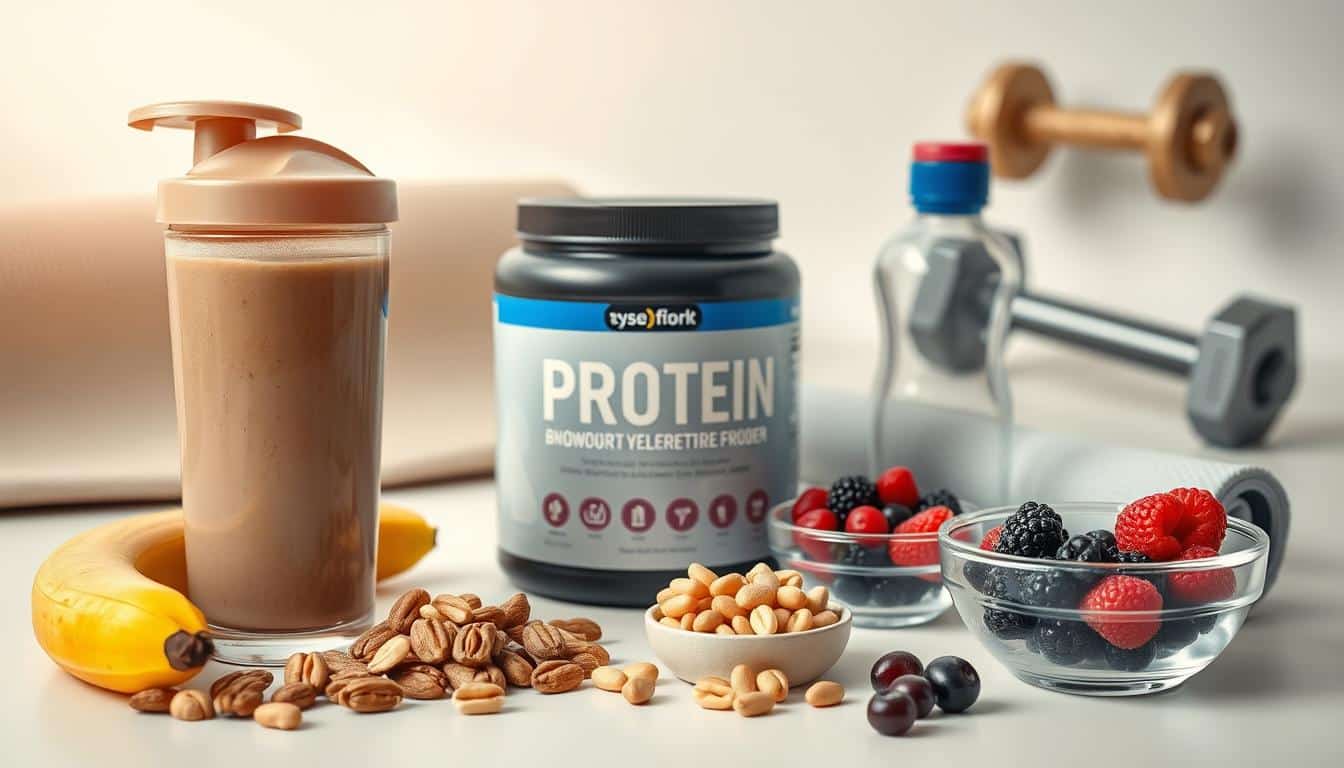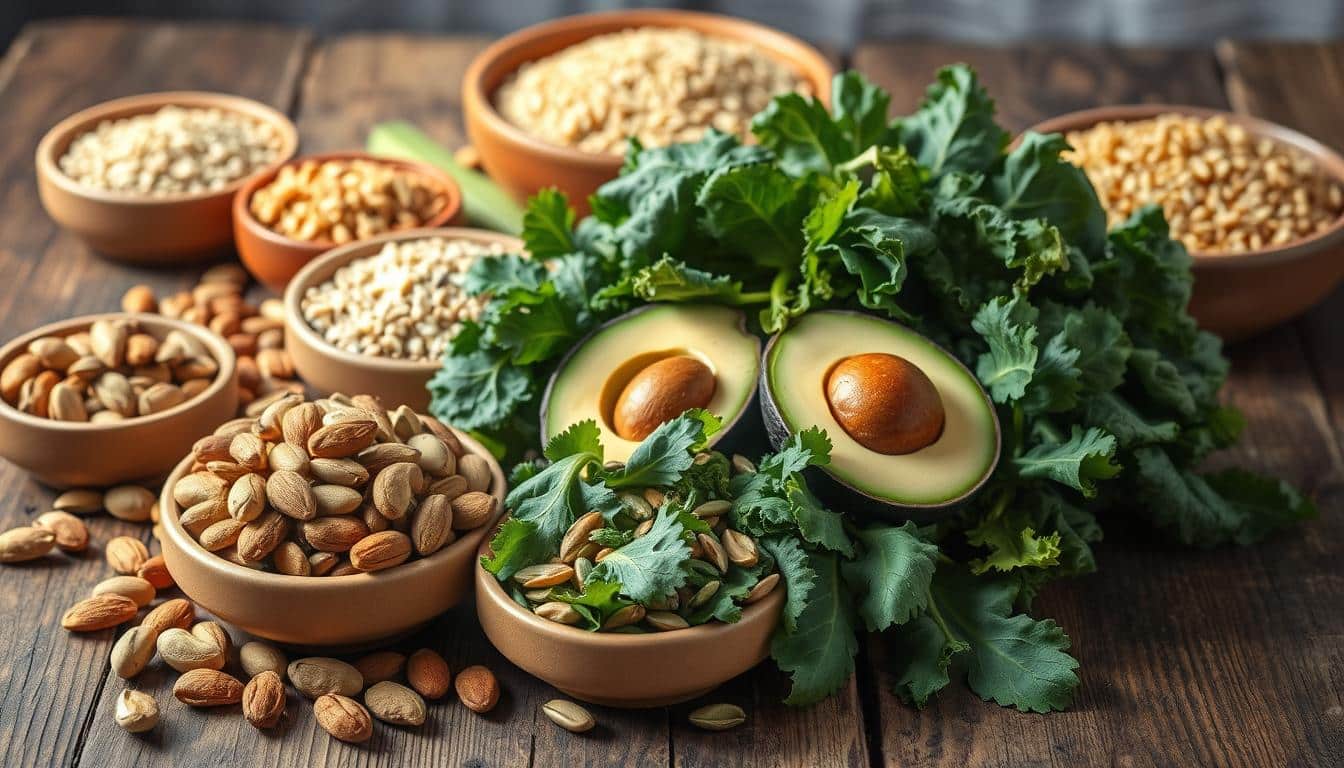Ever finish a tough workout feeling more drained than energized? Your body might be missing a critical nutrient lost through sweat. Intense exercise can deplete up to 200mg of a key mineral per hour – one that’s essential for muscle recovery and keeping your energy levels steady.
Here’s the good news: Smart meal choices can help you bounce back faster. Many active adults overlook this simple yet powerful way to support their fitness goals. We’ll show you how to refuel effectively using everyday ingredients that pack a nutritional punch.
Why focus on this particular mineral? It plays a starring role in over 300 bodily processes, from keeping your heartbeat steady to helping muscles relax. Men need about 420mg daily, but sweat sessions can wipe out nearly half that amount. That post-workout slump you sometimes feel? It might signal it’s time to rethink your recovery nutrition.
This guide cuts through the confusion. You’ll discover tasty options that naturally replenish what your body uses during training. We’ve kept it practical – no fancy supplements or complicated recipes. Just real food that works as hard as you do.
Introduction to Post-Workout Nutrition
Your post-workout plate holds the key to tomorrow’s performance. What you eat in those critical recovery hours does more than satisfy hunger – it rebuilds what exercise breaks down. Three out of four active adults focus solely on protein, but minerals and carbs matter just as much for proper repair.

Every movement you make relies on complex body processes. From steady heartbeats to muscle coordination, these systems need specific fuel to function optimally. Exercise drains resources faster than daily activities – that’s why strategic nutrition intake matters most when you’re done sweating.
Consider these essential recovery elements:
| Nutrient | Role | Best Sources |
|---|---|---|
| Protein | Muscle repair | Eggs, Greek yogurt |
| Carbs | Energy restoration | Sweet potatoes, oats |
| Minerals | Nerve function | Leafy greens, nuts |
Smart eating isn’t complicated. Pair whole foods that cover multiple needs – like a spinach omelet with toast. This combo delivers protein, carbs, and minerals in one meal. Timing matters too: aim to eat within two hours post-exercise when your body absorbs nutrients best.
Remember, recovery nutrition isn’t about perfection. It’s about consistently giving your system what it needs to rebuild stronger. Start with small changes – swap processed snacks for whole-food options, or add an extra veggie to your plate. Your future self will thank you during the next workout.
Understanding Magnesium’s Role in Recovery
Ever wonder why some days you bounce back from workouts faster than others? The answer might lie in a mineral that works like your body’s backstage crew. This nutrient keeps muscles functioning smoothly while helping convert food into usable fuel.
Think of it as a traffic controller for your nervous system. It ensures signals reach their destinations correctly, allowing tissues to contract and relax without cramping. Without proper levels, movements feel sluggish – like trying to drive with low engine oil.

Here’s how it powers your progress: Every cell uses a special molecule called ATP for energy. This mineral acts as a co-pilot in ATP production, turning nutrients into fuel you can burn during exercise. Low levels mean less available energy – even if you’ve eaten enough calories.
Your system also uses this helper to regulate stress responses. After intense training, it calms overworked fibers and supports tissue repair. That’s why adequate intake can mean the difference between soreness and swift recovery.
Don’t underestimate its behind-the-scenes work. From maintaining steady heart rhythms to optimizing hydration balance, this multitasker keeps your engine running at peak performance. Pair smart nutrition with your training routine – your gains will thank you.
Magnesium Rich Foods After Training
What you eat post-exercise can make or break your recovery game. Experts suggest getting between 310-420 milligrams of this essential mineral daily through your diet – and real meals beat pills for one key reason. Whole ingredients deliver bonus nutrients that supplements can’t match.
Your body absorbs nutrients best from sources it recognizes. Think crunchy snacks and hearty meals rather than lab-made powders. Active individuals need more due to sweat loss, but you don’t need to track every milligram. Focus on variety across your meals instead.
| Food Group | Serving Size | Approx. Content |
|---|---|---|
| Leafy Greens | 1 cup cooked | 150mg |
| Mixed Nuts | 1 oz | 80mg |
| Whole Grains | 1/2 cup dry | 60mg |
Time your intake wisely. Eating within two hours after training helps restore levels when your muscles need it most. Pair these ingredients with protein and carbs for maximum benefit – like almond butter on whole-grain toast.
Your dietary choices become simpler when you plan ahead. Keep prepped veggies and roasted seeds handy for quick post-workout snacks. Remember, consistency beats perfection. Small daily additions create lasting results.
Benefits of Magnesium for Muscle and Heart Health
Ever notice how some days your body feels ready to conquer the world after a workout? That energized feeling starts with smart recovery choices. This essential nutrient works double duty – supporting both your muscle repair and heart health simultaneously.
Powering Your Recovery Engine
Your muscles need more than protein to rebuild. This mineral helps convert food into energy your cells can use. It’s like having a personal mechanic for your body’s engine – smoothing out stiffness and refueling your tank efficiently.
| Benefit | How It Works | Key Impact |
|---|---|---|
| Energy Boost | Activates ATP production | Faster recovery |
| Muscle Support | Reduces cramping | Better mobility |
| Stress Relief | Calms nervous system | Improved sleep |
Your Heart’s Silent Partner
Your ticker works harder during exercise – it needs proper support too. This nutrient helps maintain steady rhythms and keeps blood vessels flexible. Better circulation means oxygen reaches tired muscles faster, speeding up repair time.
Research shows consistent intake supports healthy blood pressure levels over time. Pair it with other foods for muscle recovery for maximum impact. Your heart and muscles will thank you during tomorrow’s workout.
Dark Chocolate: A Sweet Source of Magnesium
Who says post-workout snacks can’t be delicious and nutritious? A square of dark chocolate offers more than just a mood boost – it’s packed with recovery-supporting minerals your body craves after exertion.
One ounce (about 28g) delivers 65mg of magnesium – 15% of your daily needs. That’s not all. This smart choice also provides iron for oxygen transport and copper for energy production. The real star? Flavanols – antioxidants that combat exercise-induced stress.
| Type | Serving Size | Magnesium Content | Key Benefits |
|---|---|---|---|
| Dark Chocolate (70%+) | 1 oz | 65mg | Antioxidants, low sugar |
| Milk Chocolate | 1 oz | 20mg | Higher sugar content |
Not all bars are created equal. Look for 70% cocoa solids or higher to maximize mineral content while minimizing added sugars. The bitter flavor profile actually signals higher nutrient density.
Pair two squares with a handful of almonds for a recovery combo that satisfies sweet cravings and replenishes electrolytes. Unlike sugary treats, quality dark chocolate provides lasting benefits without energy crashes. Your taste buds and muscles get what they need.
Avocados: Creamy and Nutritious Recovery Boost
Looking for a post-exercise snack that feels indulgent but actually fuels recovery? Meet your new green ally. This versatile fruit delivers creamy satisfaction while replenishing what your body uses during workouts.
Key Nutrients and Fiber Benefits
One medium avocado packs 58mg of a crucial mineral – 14% of your daily needs. But that’s just the start. These buttery fruits bring a powerhouse of nutrients to your plate:
| Nutrient | Amount | Key Benefit |
|---|---|---|
| Potassium | More than bananas | Muscle function |
| Healthy Fats | 15g per serving | Heart health |
| Fiber | 10g (40% DV) | Digestive support |
The secret weapon? Monounsaturated fats that help absorb vitamins from other ingredients. Spread avocado on whole-grain toast with eggs, and you create a complete recovery meal. Your heart gets love from the good fats, while fiber keeps you satisfied longer.
Research shows regular avocado eaters have better cholesterol profiles and less exercise-related inflammation. Blend them into smoothies, slice onto salads, or mash into dips – their mild flavor plays well with both sweet and savory dishes.
Forget complicated recovery strategies. Keep these green gems stocked, and you’ll always have a quick, nutrient-dense option ready when hunger strikes post-sweat.
Nuts and Seeds: A Crunchy Magnesium Boost
Crunchy snacks do more than satisfy hunger – they power your recovery. Portable and packed with nutrients, these bite-sized options deliver exactly what your body needs post-exercise. Let’s crack open the benefits of nature’s perfect gym-bag fuel.
Powerhouse Seeds for Recovery
Pumpkin seeds steal the spotlight with 168mg per ounce – that’s 40% of your daily needs in one handful. Toss them on yogurt or blend into smoothies for an easy mineral boost. Chia seeds follow close behind with 111mg per serving plus omega-3s that fight exercise-induced inflammation.
Nut Varieties That Deliver
Cashews offer 83mg per ounce alongside satisfying protein. Almonds bring 80mg plus heart-healthy fats. Both make perfect post-workout snacks when paired with fruit or dark chocolate.
| Food | Serving | Magnesium | Bonus Nutrients |
|---|---|---|---|
| Pumpkin Seeds | 1 oz | 168mg | Zinc, Iron |
| Chia Seeds | 1 oz | 111mg | Omega-3s, Fiber |
| Cashews | 1 oz | 83mg | Protein, Copper |
Keep a mix in your gym bag for quick refueling. The protein-fat-mineral combo helps muscles repair while stabilizing energy levels. Your recovery just got tastier.
Legumes: Protein-Rich and Packed with Magnesium
What if your post-workout meal could do double duty? Meet legumes – the unsung heroes of recovery nutrition. These affordable pantry staples deliver both muscle-repairing protein and essential minerals in every bite.
Power Pair: Black Beans & Chickpeas
Black beans shine with 120mg per cooked cup – that’s nearly a third of your daily mineral needs. Chickpeas follow closely at 115mg per 100g serving. Both bring bonus nutrients to the table:
| Legume | Serving | Key Nutrients |
|---|---|---|
| Black Beans | 1 cup cooked | 15g protein, 29% DV magnesium |
| Chickpeas | 100g cooked | 19g protein, 28% DV magnesium |
These plant-based powerhouses help stabilize energy levels naturally. Their low glycemic index prevents blood sugar spikes, while fiber keeps you full longer. Toss them in salads, blend into dips, or simmer in soups for versatile recovery meals.
Meal prep becomes effortless with canned versions – just rinse and add to dishes. For batch cooking enthusiasts, dried legumes offer budget-friendly nutrition. Pair them with whole grains like brown rice to create complete proteins that support muscle repair.
Your recovery routine just got simpler. Keep these nutrient-dense options stocked, and you’ll always have a smart post-workout solution ready.
Tofu and Soy: Plant-Based Recovery Options
What if your muscles could recover with foods that taste great and respect your dietary choices? Plant-powered options offer serious nutrition without compromising flavor. Soy-based products deliver the goods when your system needs replenishment most.
Versatile Protein Powerhouse
A 3.5-ounce tofu serving packs 10g of muscle-friendly protein alongside 35mg of essential minerals. This chameleon ingredient absorbs flavors like a sponge – perfect for stir-fries or morning scrambles. Bonus nutrients like calcium and iron make it a triple threat for active lifestyles.
| Food | Serving | Key Nutrients | Best Uses |
|---|---|---|---|
| Firm Tofu | 3.5 oz | 35mg mineral, 10g protein | Grilling, stir-fry |
| Soy Milk | 1 cup | 25mg mineral, 7g protein | Smoothies, oatmeal |
| Edamame | 100g | 64mg mineral, 11g protein | Snacks, salads |
Liquid Nutrition & Snack Solutions
Blend soy milk into post-workout shakes for creamy texture and extra minerals. Edamame pods provide satisfying crunch with 64mg per serving – steam them with sea salt for instant fuel. Both options keep your body fueled without heavy digestion.
Recent studies suggest regular soy consumption supports heart health and cellular protection. Whether you’re vegan or just exploring meatless meals, these products adapt to any eating style while delivering recovery benefits.
Whole Grains for Sustained Energy
Need lasting fuel that keeps up with your active life? Whole grains do more than fill your plate – they power your recovery with slow-burning energy. Unlike refined carbs that spike blood sugar, these nutritional champions release energy steadily, keeping you fueled between workouts.
The Dynamic Duo: Quinoa & Buckwheat
Quinoa stands out with 118mg per cooked cup – that’s a third of your daily mineral needs. This gluten-free seed (yes, it’s technically a seed!) packs all nine essential amino acids. Perfect for post-training bowls or hearty salads.
Buckwheat delivers 86mg per cooked cup plus rutin, an antioxidant that supports circulation. Its nutty flavor shines in pancakes or as a rice alternative. Both grains offer complex carbs that refill energy stores without crashes.
Try mixing cooked grains into yogurt parfaits or veggie stir-fries. Their versatility makes meal prep effortless – cook batches on Sunday for ready-to-go recovery meals all week. Your body will thank you during tomorrow’s training session.


